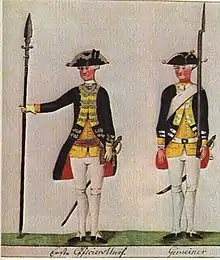Hessian (soldier)
Hessians (US: /ˈhɛʃənz/ or UK: /ˈhɛsiənz/)[1] were German soldiers who served as auxiliaries to the British Army during the American Revolutionary War.[2] The term is an American synecdoche for all Germans who fought on the British side, since 65% came from the German states of Hesse-Kassel and Hesse-Hanau. Known for their discipline and martial prowess, around 30,000 Germans fought for the British during war, comprising a quarter of British land forces.[3]
Although frequently referred to by scholars as mercenaries, Hessians were legally[2] and politically distinguished as auxiliaries; unlike mercenaries, who served a foreign government on their own accord, auxiliaries were soldiers hired out to a foreign party by their own government, to which they remained in service.[2] As a source of funding throughout the 18th century, many German states regularly rented out the services of their troops to fight in wars that they had no other involvement in. Like most auxiliaries of this period, Hessians served with foreign armies as entire units; fighting under their own flags, commanded by their usual officers, and wearing their existing uniforms.
Hessians played a key role in the Revolutionary War.[4] They served with distinction in many battles across North America, particularly in the northern theater, most notably at White Plains and Fort Washington.[4] The added manpower and skill of German troops is credited for greatly sustaining the British war effort, but it also outraged colonists and increased support for the Patriot cause.[4] The use of "large armies of foreign mercenaries" was one of the 27 colonial grievances against King George III in the Declaration of Independence, while the Patriots used the deployment of Hessians to support their claims of British violations of the colonist's rights.[5]
Origin and history
The use of foreign soldiers was not unusual in 18th century Europe. In the two centuries leading up to the American Revolution, the continent was characterized by constant warfare, and military manpower was in high demand.[6] Germany was not yet a unified nation, but a collection of several hundred states loosely organized under the Holy Roman Empire. Conflict between and among these nations led to the creation of professional armies, which were consequently experienced and well trained. Many German societies became militarized, with most men undergoing annual training from adolescence well into adulthood, often serving for life or until they were too old.[7] German states varied considerably in size and wealth, and several came to rely on their troops as an economic resource, especially since sustaining a standing army was costly.
When military conflict broke out, as it often did in Europe, German states provided a ready supply of trained troops prepared to go into action immediately. Hesse-Kassel soon emerged as the most prominent source of soldiers. To field a large professional army with a relatively small population, it became the most militarized state in Europe: 5.2% to 6.7% of its population were under arms in the 18th century—with one in four households having someone serving in the army—a larger proportion than even heavily-militarized Prussia.[8][9] Whereas Prussia relied partly on mercenaries from other German states, Hesse-Kassel employed only Landeskinder, native men.[10] The military was the dominant force in the country. All Hessian males were registered for military service at the age of seven, and from the age of 16 until 30, had to annually present themselves to an official for possible recruitment. Only those whose occupation was considered vital to the country could be exempt. Those deemed "expendable", such as vagrants and the unemployed, could be conscripted at any time.
Hessian military service was notably strict and demanding, emphasizing iron discipline through draconian punishment. However, morale was generally high, and soldiers were said to take pride in their service. Officers were usually well-educated and, in contrast to most European armies, promoted on the basis of merit. Soldiers were paid relatively high wages, and their families were exempt from certain taxes. Although plunder was officially verboten (forbidden), it remained common practice (as in most military forces at the time), offering another incentive for service.[6] Overall, Hessian troops were considered superb fighters, even by their opponents.[6]
The Hessian military became a major source of economic strength. Hesse-Kassel manufactured its own weapons and uniforms, and its textile industry was so prosperous from supplying the military that workers could afford to buy meat and wine every day. The revenue from renting the army to the British equaled roughly thirteen years' worth of taxes,[6] allowing the Landgrave of Hesse-Kassel, Friedrich II, to reduce taxes by one-third between the 1760s and 1784.[9][11] A self-styled Enlightened despot, he also oversaw public works projects, administered a public welfare system, and encouraged education.[6] The American historian Edward Jackson Lowell lauded Friedrich II for spending British money wisely, describing him as "one of the least disreputable of the princes who sent mercenaries to America".[12]
Well before the American Revolutionary War, Hessian soldiers were familiar in battlefields across 18th century Europe.
Between 1706 and 1707, 10,000 Hessians served as a corps in Eugene of Savoy's army in Italy before moving to the Spanish Netherlands in 1708. In 1714, 6,000 Hessians were rented to Sweden for its war with Russia whilst 12,000 Hessians were hired by George I of Great Britain in 1715 to combat the Jacobite Rebellion. ... In the midst of the War of the Austrian Succession in 1744, 6,000 Hessians were fighting with the British army in Flanders whilst another 6,000 were in the Bavarian army. By 1762, 24,000 Hessians were serving with Ferdinand of Brunswick's army in Germany.
— John Childs, Rethinking Leviathan[13]
In most of these wars, Hesse-Kassel was never formally a belligerent. While its troops remained members of the Hessian military, and even fought in their national uniform, they were hired out for service in other armies, without their government having any stake in the conflict. Thus, it was possible for Hessians to serve on opposing sides of the same conflict. In the War of the Austrian Succession, both Britain and Bavaria employed Hessian soldiers against one another; in the Seven Years' War, the forces of Hesse-Kassel served with both the Anglo-Hanoverian and the Prussian armies against the French; although Hesse-Kassel was technically allied to Britain and Prussia, her troops were actually leased by the British.[14]
Nevertheless, the practice of lending out auxiliaries did sometimes result in direct consequences. In July 1758, during the course of the Seven Years' War, most of Hesse-Kassel, including its capital, was occupied by a French army under Charles de Rohan, Prince of Soubise, which easily overcame the home defence force of 6,000 Hessian militiamen. Soubise ordered his troops to live off the land, take high-ranking hostages, and extort payments of cash and produce, with the intention of forcing Hessian troops to withdraw from the war. Hessian and allied forces attempted to liberate their homeland but were repulsed at the Battle of Sandershausen on 23 July. Following two sieges of Cassel, in 1761 and 1762, the capital was retaken, which constituted the last military action of the war.[15]
"Mercenaries" versus "auxiliaries"
The characterization of Hessian troops as "mercenaries" remains controversial over two centuries later. American history textbooks refer to them as "mercenaries", and they are still widely perceived as such in popular imagination within the United States.[16] American historian Charles Ingrao describes Hesse as a "mercenary state" whose prince rented out his regiments to fund his governmental expeditures.[17] By contrast, British historian Stephen Conway referred to them as "auxiliaries".[18] Canadian military historian Rodney Atwood notes that, contrary to some Patriot propaganda and perceptions, Hessians would not have been considered mercenaries at the time, but rather auxiliaries. Eighteenth century jurists distinguished mercenaries as those who served a foreign prince as individuals, whereas auxiliaries served their prince and were sent to the aid of another prince.[2]
Hessians would not be categorized as mercenaries under modern international law. Protocol I (1977) to the Geneva Convention defines a mercenary as "any person who ... has not been sent by a State which is not a Party to the conflict on official duty as a member of its armed forces."[19] Hessian troops served in America on official duty from the armed forces of Hesse-Cassel and Hesse-Hanau. Protocol I also requires a mercenary to be "promised, by or on behalf of a Party to the conflict, material compensation substantially in excess of that promised or paid to combatants of similar ranks and functions in the armed forces of that Party."[19] While not formally incorporated into the British military, Hessian troops were paid the same wages as British soldiers.[20]
Service during the American Revolution
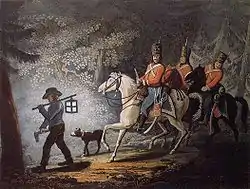
Great Britain maintained a relatively small standing army, so it found itself in great need of troops at the outset of the American Revolutionary War. Several German princes saw an opportunity to earn some extra income by hiring out their regular army units for service in America. Their troops entered the British service not as individuals but in entire units, with their usual uniforms, flags, equipment, and officers. Methods of recruitment varied according to the state of origin. The contingent from Waldeck for example was drawn from a principality army based on universal conscription, from which only students were exempt.[21] Other German princes relied on long-service voluntary enlistment supplemented by conscription when numbers fell short.[22] Many of the princes were closely related to the House of Hanover and were comfortable placing their troops under British command.
A total of 29,875 German troops fought alongside British troops in the Revolutionary War, of which 16,992 came from Hesse-Kassel and 2,422 from Hesse-Hanau. Other contingents came from Brunswick (4,300), Ansbach-Bayreuth (2,353), Anhalt-Zerbst (1,119) and Waldeck (1,225).[23] Since the majority of the German troops came from Hesse, Americans use the term Hessians to refer to all German troops fighting on the British side.[16]
Deployment
Hessian troops included jägers, hussars, three artillery companies, and four battalions of grenadiers. Most infantrymen were chasseurs (sharpshooters), musketeers, and fusiliers. Line infantry was armed with muskets, while the Hessian artillery used the three-pound cannon. The elite jäger battalions used the büchse, a short, large-caliber rifle well-suited to woodland combat. Initially, the average regiment was made up of 500 to 600 men. Later in the war, due to death in battle, death by disease, and general desertion to settle in the Colonies, the regiments may have been reduced to only around 300 to 400 men.
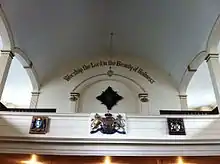
The first Hessian troops to arrive in North America landed at Staten Island, New York on August 15, 1776. Their first engagement was less than two weeks later, in the Battle of Long Island, the first major battle in the war. Hessians proved decisive to the British victory, and subsequently fought in almost every battle that year.
By 1777, the British used them mainly as garrison and patrol troops. An assortment of Hessians fought in the battles and campaigns in the southern states during 1778–1780 (including Guilford Courthouse), and two regiments fought at the Siege of Yorktown in 1781. Hessians also served in Nova Scotia for five years (1778–1783), where they protected the colony from American privateers, such as during the 1782 Raid on Lunenburg. They were led by Baron Oberst Franz Carl Erdmann von Seitz, who is commemorated in a church in Halifax.[24]
Notwithstanding their reputation as skilled and disciplined fighters, many British soldiers shared the American distrust of Hessians, who often spoke little or no English and were perceived as crude and barbaric.
The chaplain then recounts the case of a Jaeger subaltern who was assailed "by an Englishman in his cups" with the declaration: "God damn you, Frenchy, you take our pay!" The outraged Hessian replied: "I am a German and you are a shit." This was followed by an impromptu duel with hangers, in which the Englishman received a fatal wound. The chaplain records that General Howe pardoned the Jaeger officer and issued an order that "the English should treat the Germans as brothers." This order began to have influence only when "our Germans, teachable as they are" had learned to "stammer a little English." Apparently, this was a prerequisite for the English to show them any affection.[25]
Hessians, for their part, spoke out against executions of captured prisoners of war after the Battle of Long Island, especially since many were of German descent; one Hessian is quoted as saying that "many among them were Germans, and that cut me doubly to the heart". One American woman spoke to the Hessians of her re-appraisal of them after the battle, as they refused to take part in any plundering: "she saw very plainly there was no truth in what people had told her of the Hessians, namely that they were cruel".[26]
American attitudes
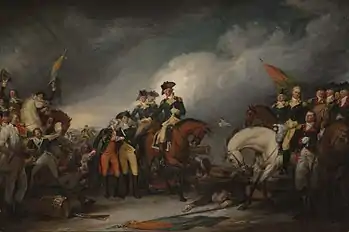
Americans, both Patriot and Loyalist, often feared the Hessians, believing them to be rapacious and brutal mercenaries. The American Declaration of Independence, written roughly a year after hostilities broke out, condemned King George III of "transporting large Armies of foreign Mercenaries to [complete] the works of death, desolation and tyranny, already begun with circumstances of Cruelty & perfidy scarcely paralleled in the most barbarous ages, and totally unworthy the Head of a civilized nation." Throughout the war, reports of plundering by Hessians were said to have galvanized neutral colonists to join the Patriot side.
General Washington's Continental Army had crossed the Delaware River to make a surprise attack on the Hessians in the early morning of December 26, 1776. In the Battle of Trenton, the Hessian force of 1,400 was quickly overwhelmed by the Continentals, with only about 20 killed and 100 wounded, but 1,000 captured.[27]
The Hessians captured in the Battle of Trenton were paraded through the streets of Philadelphia to raise American morale; anger at their presence helped the Continental Army recruit new soldiers.[28] Most of the prisoners were sent to work as farmhands.[29]
By early 1778, negotiations for the exchange of prisoners between Washington and the British had begun in earnest.[30] These included Nicholas Bahner(t), Jacob Trobe, George Geisler, and Conrad Grein (Konrad Krain),[31] who were a few of the Hessian soldiers who deserted the British forces after being returned in exchange for American prisoners of war.[32] These men were both hunted by the British for being deserters and by many of the colonists as a foreign enemy.
Throughout the war, Americans tried to entice Hessians to desert the British, emphasizing the large and prosperous German-American community. The U.S. Congress authorized the offer of land of up to 50 acres (roughly 20 hectares) to individual Hessian soldiers that switched sides.[33] British soldiers were offered 50 to 800 acres, depending on rank.[34]

Many Hessian prisoners were held in camps at the interior city of Lancaster, Pennsylvania, home to a large German community known as the Pennsylvania Dutch. German prisoners were subsequently treated well, with some volunteering for extra work assignments, helping to replace local men serving in the Continental Army. After the war, many POWs never returned to Germany and instead accepted American offers of religious freedom and free land, becoming permanent settlers – one of which was the 5th great grandfather of American actor Rob Lowe. By contrast, British prisoners were also held in Lancaster, but these men did not respond favorably to good treatment and often tried to escape.[35]
After the war ended in 1783, some 17,313 German soldiers returned to their homelands. Of the 12,526 who did not return, about 7,700 had died; some 1,200 were killed in action, and 6,354 died from illnesses or accidents, mostly the former.[36] Approximately 5,000 German troops, most of whom had been press-ganged or conscripted in their countries of origin, opted to settle in either the United States or Canada.
Commanding officers
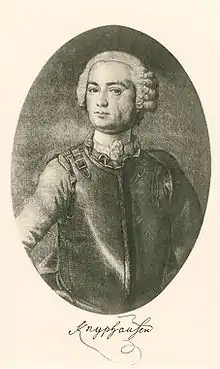
- Wilhelm von Knyphausen
- Oberst Franz Carl Erdmann Freiherr (Baron) von Seitz – led the regiment in the Battle of Fort Washington[37]
- Oberst Johann Rall, commanding officer of the Hessian forces at the Battle of Trenton
- Lieutenant General Friedrich Wilhelm von Lossberg, as Colonel led the von Lossberg Regiment (Alt) at the [Battle of White Plains] and [Fort Washington]. He served in [Newport] from 1776 until 1779 and played a decisive role at the [Battle of Rhode Island]. In May 1782 upon the departure of Lieutenant General Knyphausen, Lossberg replace him as the commander of the Hessian troops in North America.
Units
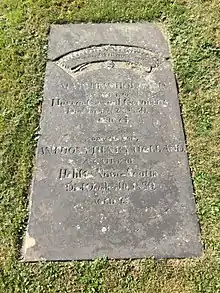
- Hesse-Cassel Jäger Corps (Hessisches Jägercorps zu Pferd und zu Fuß)
- Fusilier Regiment von Ditfurth (Füsilier-Regiment "von Ditfurth")
- Fusilier Regiment Erbprinz, later (1780) Musketeer Regiment Erbprinz (Füsilier-Regiment "Erbprinz"; Infanterie-Regiment "Erbprinz")
- Fusilier Regiment von Knyphausen (Füsilier-Regiment "von Knyphausen")
- Fusilier Regiment von Lossberg (Füsilier-Regiment "von Lossberg")
- Grenadier Regiment von Rall, later (1777) von Woellwarth; (1779) von Trümbach; (1781) d'Angelelli (Grenadier-Regiment "von Rall"; "von Woellwarth"; "von Trümbach"; "d'Angelelli")
- 1st Battalion Grenadiers von Linsing
- 2nd Battalion Grenadiers von Block (later von Lengerke)
- 3rd Battalion Grenadiers von Minnigerode (later von Löwenstein)
- 4th Battalion Grenadiers von Köhler (later von Graf; von Platte)
- Garrison Regiment von Bünau (Garrisons-Regiment)
- Garrison Regiment von Huyn (later von Benning)
- Garrison Regiment von Stein (later von Seitz; von Porbeck)
- Garrison Regiment von Wissenbach (later von Knoblauch)
- Leib Infantry Regiment (Leib-Infanterie-Regiment)
- Musketeer Regiment von Donop
- Musketeer Regiment von Trümbach (later von Bose (1779))
- Musketeer Regiment von Mirbach (later Jung von Lossburg (1780))
- Musketeer Regiment Prinz Carl
- Musketeer Regiment von Wutgenau (later Landgraf (1777))
- Hesse-Cassel Artillery corps (Artillerie-Korps)
Cavalry:
- First Dragoon Cavalry Regiment (1804–1812, red jacket); change to the First Light Dragoon Cavalry Regiment (1812–1816, blue jacket)
- Second Dragoon Cavalry Regiment (1805–1812, red jacket); change to the Second Light Dragoon Cavalry Regiment (1812–1816, blue jacket)
- First Hussar Regiment;
- Second Hussar Regiment;
- Third Hussar Regiment;
Infantry:
- First Light Infantry Battalion;
- Second Light Infantry Battalion;
- First Formation Infantry Battalion;
- Second Infantry Battalion;
- Third Formation Infantry Battalion;
- Fourth Formation Infantry Battalion;
- Fifth Formation Infantry Battalion;
- Sixth Formation Infantry Battalion;
- Seventh Formation Infantry Battalion;
- Eighth Formation Infantry Battalion;
Artillery and engineers:
- The British and German artillery had two artillery companies and three infantry companies.
- King of England and German engineers;
These troops were stationed at sea in Bexhill on Sea and Weymouth, and some later went to Ireland.
In popular culture
- Hessian fly, a significant pest of cereal crops, was named after its supposed arrival in North America in Hessian soldiers' straw bedding.
- Washington Irving's story "The Legend of Sleepy Hollow" (1820) includes a celebrated figure known as the "Headless Horseman" who is "the ghost of a Hessian trooper, whose head had been carried away by a cannon-ball, in some nameless battle during the Revolutionary War." He has been portrayed in many dramatic adaptations of the story.
- D. W. Griffith co-wrote and directed the short film, The Hessian Renegades (1909), about the early stages of the American Revolution.
- In the Merrie Melodies short Bunker Hill Bunny (1950), set during the Revolutionary War, Bugs Bunny faces off against Hessian soldier Sam von Schamm.
- The final episode of the cartoon series The Super 6 (1967) features Capt. Zammo in "The Hessians Are Coming" where, after a parody of Paul Revere's midnight ride, Captain Zammo and Private Hammo are dispatched to zip back in time to 1776 and report to General George Washington in order to foil the malicious machinations of the marauding invaders.
- The 1972 novel The Hessian, by Howard Fast, concerns a young Hessian drummer who is executed in reprisal for the mistaken hanging of an autistic villager by his officer.
- In the television series Turn: Washington's Spies, Hessians are depicted in Season 1 as participating in the Battle of Trenton and meet Abraham Woodhull in New York.
References
- Jones, Daniel (2011). Roach, Peter; Setter, Jane; Esling, John (eds.). "hessian". Cambridge English Pronouncing Dictionary (18th ed.). Cambridge University Press. ISBN 978-0-521-15255-6.
- Atwood, Rodney (1980). The Hessians: Mercenaries from Hessen-Kassel in the American Revolution. Cambridge, England: Cambridge University Press.
- Alan Axelrod (9 January 2014). Mercenaries: A Guide to Private Armies and Private Military Companies. SAGE Publications. p. 66. ISBN 978-1-4833-4030-2.
- "Hessians". American Battlefield Trust. 2017-01-25. Retrieved 2020-06-24.
- Benjamin Franklin, “The Sale of the Hessians,” (1777).
- "Hessians". George Washington's Mount Vernon. Retrieved 2020-06-24.
- Charles Ingrao, The Hessian Mercenary State, (Cambridge: Cambridge University Press, 2003), p. 2.
- Black, Jeremy (1994). European Warfare, 1660–1815. London: Routledge. ISBN 978-1-13536955-2.
Whereas in the mid-eighteenth century, Austria and Russia had between approximately 1.1 per cent and 1.5 per cent of their population in the army, the percentage for Prussia for 4.2. ... In 1730, a year of peace but also of war preparations, Hesse-Cassel had 1 in 19 of the population under arms.
- Showalter, Dennis (5 September 2007). "Hessians: The Best Armies Money Could Buy". HistoryNet. Retrieved 28 May 2018.
- Mollo, John (1975). Uniforms of the American Revolution. p. 26. ISBN 0-02-585580-8.
- Showalter, Dennis; Astore, William J. (2007). The Early Modern World. Soldiers' Lives Through History. 3 (1 ed.). Westport, Connecticut: Greenwood Press. ISBN 978-0-313-33312-5.
- Lowell, Edward J. (1884). The Hessians and the Other German Auxiliaries of Great Britain in the Revolutionary War. New York: Harper.
- Brewer, John; Hellmuth, Eckhart, eds. (1999). Rethinking Leviathan: The Eighteenth-Century State in Britain and Germany (1st ed.). Oxford: Oxford University Press. ISBN 9780199201891.
- Reid, Stuart (2010). Frederick the Great's Allies 1756–63. Osprey Publishing. p. 5. ISBN 978-1849081771.
Next in importance came the armies of Hesse-Kassel (not to be confused with Hesse-Darmstadt) and Brunswick, which were not allied contingents in a political sense, but were directly leased by the British government.
- Szabo, Franz A.J. (5 November 2013). The Seven Years War in Europe: 1756–1763. Pearson Education Limited. p. 180. ISBN 978-0582292727.
- Kennedy, David M. (2012). The American Pageant. Cengage Learning. p. 147.
Because most of these soldiers-for-hire came from the Germany principality of Hesse, the Americans called all the European mercenaries Hessians.
- Charles W. Ingrao, The Hessian mercenary state: ideas, institutions, and reform under Frederick II, 1760–1785 (Cambridge University Press, 2003)
- Conway, Stephen (2017). Britannia's Auxiliaries: Continental Europeans and the British Empire, 1740–1800. Oxford University Press. ISBN 9780192536136.
- "Protocols Additional to the Geneva Conventions of 12 August 1949" (PDF).
- Taylor, Peter Keir (1994). Indentured to Liberty: Peasant Life and the Hessian Military State, 1688-1815. Cornell University Press. p. 22. ISBN 9780801429163.
The British also undertook to pay each Hessian soldier at British rates of pay.
- Mollo, John (1975). Uniforms of the American Revolution. p. 27. ISBN 0-02-585580-8.
- Mollo, John (1975). Uniforms of the American Revolution. p. 28. ISBN 0-02-585580-8.
- Mollo, John (1975). Uniforms of the American Revolution. pp. 24–27. ISBN 0-02-585580-8.
- "Col Franz Carl Seitz (1719–1782) – Find A Grave Memorial". www.findagrave.com. Retrieved 2016-09-16.
- Schwamenfeld 2007, p. 123
- Steven Schwamenfeld. "The Foundation of British Strength: National Identity and the Common British Soldier." Ph.D. diss., Florida State University 2007, p. 123-124
- "Battle of Trenton", British Battles.com, accessed 13 Feb 2010
- Johannes Schwalm the Hessian, p. 21
- Rodney Atwood (2002). The Hessians. Cambridge University Press. p. 199. ISBN 9780521526371.
- Herbert M. Bahner and Mark A. Schwalm, "Johann Nicholas Bahner – From Reichenbach, Hessen To Pillow, Pennsylvania", Journal of the Johannes Schwalm Historical Association, Inc. Vol. 3, No. 3, 1987
- "Konrad Krain". silvie.tripod.com.
- [Journal of Johannes Schwalm Historical Assoc., Inc Vol. 3, No. 1, p. 2]
- "LIBERTY! . The Hessians | PBS". www.pbs.org. Retrieved 2020-06-24.
- R. Douglas Hurt (2002) American Agriculture: A Brief History, p. 80
- Ken Miller, Dangerous Guests: Enemy Captives and Revolutionary Communities during the War for Independence (Cornell Univ. Press, 2014) online review
- "Revolutionary War – The Hessian involvement". MadMikesAmerica. Retrieved 2012-10-29.
- Colonel of the Hesse Cassel Garrison Regiment Von Seitz – see Hessian (soldiers). The Baron fought in the American Revolution, particularly on 16 November 1776, he captured Fort Washington; 1776–1778, Garrisoned New York; 1778–1783, Garrisoned Halifax. See "The Hessians of Nova Scotia" by John H Merz and Winthrop P. Bell entitled, "A Hessian conscript's account of life in garrison at Halifax at the time of the American Revolution". Collections of the Nova Scotia Historical Society, Volume 27, 1947
Sources
- Atwood, Rodney. The Hessians: Mercenaries from Hessen-Kassel in the American Revolution (Cambridge University Press, 1980), the standard scholarly history
- Crytzer, Brady J. Hessians: Mercenaries, Rebels, and the War for British North America (2015). excerpt
- Faust, Albert B. (1909). The German Element in the United States. I. Boston: Houghton & Mifflin. pp. 349–356.
- Fischer, David Hackett (2004). Washington's Crossing. Oxford university Press. p. 517.
- Ingrao, Charles. "'Barbarous Strangers': Hessian State and Society during the American Revolution", American Historical Review (1982) 87#4 pp. 954–976 in JSTOR
- Ingrao, Charles W. The Hessian mercenary state: ideas, institutions, and reform under Frederick II, 1760–1785 (Cambridge University Press, 2003)
- Krebs, Daniel. "Useful Enemies: The Treatment of German Prisoners of War during the American War of Independence," Journal of Military History (2013), 77#1 pp 9–39.
- Lowell, Edward J. (1884). The Hessians. New York: Harper & Brothers.
- Mauch, Christof. ""Images of America—Political Myths-- Historiography: 'Hessians' in the War of Independence", Amerikastudien (2003) 48#3 pp 411–423
- Mellick, Jr., Andrew D. (1889). "Chapter XXV: The Hessians in New Jersey". The Story of an Old Farm. Somerville, New Jersey: The Unionist-Gazette. pp. 352–370. ISBN 9780722202470.
- Miller, Ken, Dangerous Guests: Enemy Captives and Revolutionary Communities during the War for Independence (Cornell Univ. Press, 2014) online review
- Neimeyer, Charles Patrick. America Goes to War: A Social History of the Continental Army (1995) complete text online
- Rogers, Alec D. "The Hessians: Journal Of The Johannes Schwalm Historical Association" Journal of the American Revolution (2018) Online
Primary sources
- Winthrop P. Bell, ed. "A Hessian conscript's account of life in garrison at Halifax at the time of the American Revolution". Collections of the Nova Scotia Historical Society, Volume 27, 1947
- Johann Conrad Döhla. A Hessian Diary of the American Revolution (1993)
- Ewald, Johann (1979). Tustin, Joseph P. (ed.). Diary of the American War: a Hessian Journal. Yale University Press.
- Valentine C. Hubbs, ed. Hessian journals: unpublished documents of the American Revolution (Camden House, 1981), translation of the Von Jungkenn manuscripts.
External links
| Wikimedia Commons has media related to Hessian (soldiers). |
| Wikisource has original text related to this article: |
| Wikisource has original text related to this article: |
